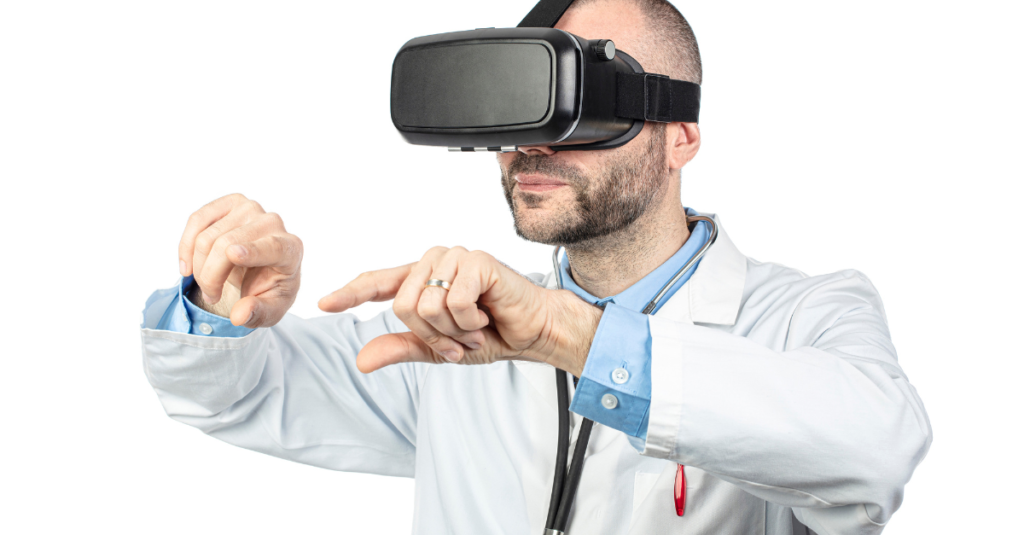Throughout our digital health series so far, we’ve looked at multiple facets of healthcare, following the patient journey from the pre-diagnosis stages to appointments, diagnosis, and post-diagnosis care, as well as looking at data security in modern healthcare systems. In this final instalment of the series, we wanted to turn our attention to the future of technology in the medical field and explore the ways in which augmented reality (AR), virtual reality (VR), and the metaverse can contribute to the expansion of healthcare services.
At present, the VR market is worth approximately $12 billion and is expected to grow to $87 billion by 2030. Although people more commonly think about AR and VR within the context of gaming, it certainly isn’t the only industry to adopt this technology: some of the top industries using virtual reality tech include education, architecture, sports, and even tourism. AR is also very popular in the manufacturing, mining, and maritime industries as it lets trainees explore difficult scenarios and become better equipped to handle them in the real world.
While training people using AR and VR is not new, innovations in the field have made it more effective than ever to learn using these technologies. Research conducted by PwC into the effectiveness of VR training showed that people learning via virtual reality were able to complete their training 4 times faster than their colleagues who used traditional classroom methods; they were also 40% more confident in their skills and 35% more able to act on what they’d learned. Alongside this, virtual reality training proved to be less expensive than e-learning study for large-scale training courses: according to PwC, class sizes of 3000 VR learners achieved a cost saving of 52% compared to their classroom-based e-learning colleagues, with 1950 VR learners being the baseline for equal costs for VR learners and e-learners. This reduction in price and increase in performance is a highly enticing aspect of VR as it creates opportunities for hands-on learning that builds muscle memory in a safe environment as there is no patient risk involved.

In November 2021, Novarad announced the release of an extension to its world’s first FDA-cleared AR surgical system, OpenSight (which uses Microsoft HoloLens smartglasses) called the OpenSight™ Augmented Reality System for Education. The system is designed to provide learners with a collaborative, innovative, and interactive learning experience using 3D holographics of donor studies performed with a CT machine and using the Microsoft HoloLens 2 headset. The holograms can be manipulated using a wide range of voice commands that allow learners to freeze slices (views from the CT scan), rotate their view, zoom in/out, expose soft tissue or bone, and more. This revolutionary step forward in medical education can help make surgeries minimally invasive and improve recovery times, as well as increase the success rate of complex procedures.
This is where the metaverse can really come into the healthcare space as it can not only facilitate training but also help with diagnosis and treatment by leveraging VR and AR together. The immersive experiences created by this technology mean that practitioners and patients alike can connect with specialists across the world and learn from them in real-time, or seek treatment for less-understood conditions that have fewer specialists globally. Metaverse technology could be used to treat a range of mental health disorders such as anxiety; facilitate group therapy with participants from remote locations; and lots more. Studies have already shown positive results in the treatment of psychiatric disorders using virtual reality by assisting in the formation of positive long-term habits as part of treatment and improving patients’ quality of life.
There are also numerous physical health benefits of AR and VR technology, for example, coach-led exercises such as Supernatural, or gamified sporting experiences such as Fitxr which uses a points system to track and motivate progress. Many of these types of fitness programmes are designed to be visually appealing as well as physically active and help to transport participants away from their everyday scenery and boost mental well-being, provide better relaxation through meditation or improve cardiovascular health through high-impact activity, or simply provide creative ways for users to improve their fitness levels through smaller movements.
While these types of treatments are primarily for adults, there are similar immersive, therapeutic options for children, notably EndeavorRx, the first FDA-authorised video game for treating ADHD in children aged 8-12 years old. The game can be “prescribed” in conjunction with an ongoing treatment plan and was designed by neuroscientists with an aim to stimulate the parts of the brain that play a key role in attention function to create positive changes from a young age. In clinical trials performed by the EndeavorRx team, 68% of parents reported an improvement in their child’s behaviour after two months of treatment – showcasing the potential of immersive tech on a wider scale, especially as a fun and practical activity.
With the unlimited possibilities of AR and VR technology, it’s easy to see why this trend has so much momentum in the healthcare industry and beyond. Find out more about the potential of AR and VR at our upcoming webinar, The Pioneering Digital Health Trends Changing The World, on Thursday 17th of November from 10am (GMT). The session is free to attend and will include a live Q&A session at the end.
Interested in introducing AR and VR projects into your organisation? Speak to the team at Zudu about the best ways to incorporate this technology into your service offering.
Download our free whitepaper on the Pioneering Digital Health Trends Changing The World.




